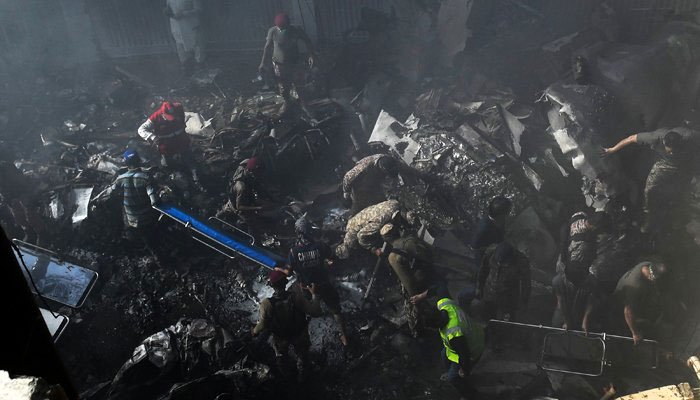Violation of multiple SoPs led to fatal PIA plane crash
Pilot was way beyond safe landing speed and altitude as close as 4 nautical miles
May 25, 2020

Multiple standard operating procedures were violated in the fatal crash of PK-8303 both by cockpit crew and air traffic control as apparently the relevant warning signals and alarms in Airbus 320 were ignored which eventually led to the disaster.
The Airbus has 21 types of warning signals and alarms to handle different situations.
Pilot was way beyond safe landing speed and altitude as close as 4 nautical miles and the Aerodrome Controller failed to check and raise alarm over the deployment of landing gear which led to a near disastrous first attempt to land. As a result, the plane engine scraped the runway surface thrice between 4,500 ft to 8,000 ft on the 10,500 ft runway which eventually led to the failure of the engines and the crash.
If there was required coordination between ATC and pilot to avoid the disastrous first attempt to land, there was enough fuel in plane to fly another one hour and ten minutes. During this time, backup checks on landing gear could have been done or in worst case, preparations could have been done for a belly landing. ATC in the last few seconds before pilot declared Mayday, asked cockpit, “confirm will you do belly landing” but it was too late by then.
A detailed inquiry based on decoding of black boxes i.e. Digital Flight Data Recorder (DFDR) and Cockpit Voice Recorder (CVR) will determine if the pilot ignored warning from Electronic Ground Proximity Warning system (EGPWS) and Electronic Centralized Aircraft Monitoring system (ECAM) about problems with landing gear if any. Or the pilot simply forgot to deploy the landing gear.
Also read: PIA plane crash: Pilot ignored 3 warnings from Air Traffic Control to lower altitude
Role of the ATC shall be scrutinised also as the ATC cross checks with cockpit if landing gears are down and locked and there are three Greens. The three Greens on cockpit console indicate if the Nose Gear and Two Main Gears are deployed and locked.
When the plane enters the 25 nautical miles area, the CAA Approach Radar Control takes over and guides the plane to landing. In parallel, CAA Aerodrome Control keeps monitoring the visual and other profile of the aircraft and keeps informing the Approach Radar Control via intercom.
The pilot lowers landing gear at 5 Nautical Miles limit , then the Aerodrome Controller asks cockpit to confirm if the landing gear is down and locked as the landing gears must be deployed at this stage.
CAA and ASF vigilant cameras would have the recording of the airplane first attempt at landing to determine if the landing gear were deployed or not.
In the 1980s, a PIA 747 did belly landing at Islamabad airport after the pilot forgot to deploy the landing gear. The mystery about deployment of landing gear deepens as in second attempt to land PK 8303, the landing gears can be seen deployed. Earlier, Approach Control Radar had thrice warned the pilot that it was overshooting speed and altitude and to readjust from 15 nautical miles on wards when plane was at 10,000 ft.
Also read: Preliminary report of PIA plane crash raises serious questions
Perturbed, the Approach controller, at 05 nautical miles when plane was still too high at 3500 told pilot to discontinue approach and turn left to 180 degrees to readjust speed and altitude.
However, the pilot over ruled all these warnings and locked ILS for runway to land. Questions are cropping up that in this intense adjustment of sharp descent 15000 ft at 15 nautical miles to 1500 ft at 4 Nautical mile, did the pilot forget to deploy landing gear.
Only a detailed probe will reveal about the problem with landing gear as to whether it was a maintenance issue or simply an error to deploy landing gear. Typically, in response to EGPWS and ECAM warning, the pilots go for a Go around and use other options to overcome landing gear problems and in worst circumstances go for belly landing.
Runway Inspection as recorded in video reveals clear marks of engine/s scraping at three points from 4500 ft on wards till 8000 ft mark.
Once the plane lifted off for Go around after first attempt to land, its left engine had started emitting smoke and later the right engine gave way also in the seven-minute period between first attempt to land and the crash. Due to the scrapping of the engines, hydraulic fluid and oil started leaking out from pipes that were scraped at bottom of engine.
This resulted in hydraulic failure after all hydraulic fluid leaked out from ruptured hydraulic pipes on bottom of scraped engine which led to other complications. At this point, Ram Air Turbine or manual gear drop deployed to solve landing gear issue which are visible in pictures of the ill-fated plane which also show scrapped engines.
Apparently as hydraulic oil rapidly leaks out from oil sumps on bottom of scraped engine, both engines had shut down without oil and plane went into glider mode with no thrust. As shown in pictures at crash site, Fan blades in engine are intact which means engines were not running when plane crashed. Since both engines stopped working, plane rapidly lost altitude during approach and crashes just minutes before runway.
The performance of Air Safety Department will come into heavy scrutiny after this crash as PIA pilots and engineers have been repeatedly warned of different shortcomings in the past. The pilot in this case was highly experienced with over 17000 flying hours but his operational and physical state especially if fasting needs to be probed. There are many issues between present PIA management and PALPA over Pilot working issues.
The said plane was leased to PIA by GE Capital in 2014 and was made in 2004 and is a mid-life aircraft. The Flight Data recorder analyses nearly 2500 parameters and a detailed probe plus other evidence available by a strong inspection team will unravel the blunders involved.
It has tragically cut short many innocent lives and badly tarnished country aviation , tourism and business image at the Aviation hub of the country. Prime Minister Imran Khan needs to revisit his pledge to reform State Enterprises like PIA which are a continuous drain on national economy with colossal annual losses of over Rs 200 billion which are met through additional borrowing.











